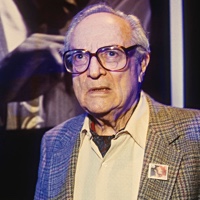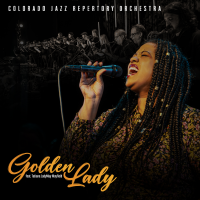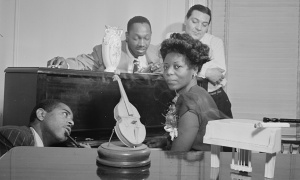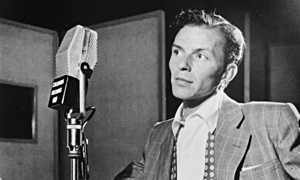Home » Jazz Articles » The Golden Age of Jazz » Sinatra In The Studio
Sinatra In The Studio
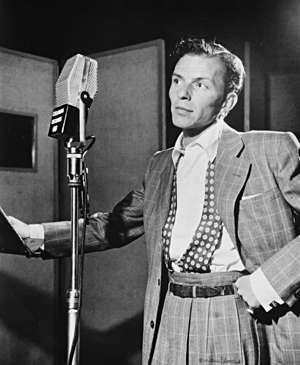 Back in 1947, I covered, for kicks, a Frank Sinatra Columbia record date, produced in New York at Liederkranz Hall. There was an acoustically superb studio large enough to handle the sumptuous, full-fiddle orchestra assembled by Axel Stordahl, the leader and arranger. In the band were many of the city's top studio musicians, a stimulating sight.
Back in 1947, I covered, for kicks, a Frank Sinatra Columbia record date, produced in New York at Liederkranz Hall. There was an acoustically superb studio large enough to handle the sumptuous, full-fiddle orchestra assembled by Axel Stordahl, the leader and arranger. In the band were many of the city's top studio musicians, a stimulating sight. Dominating the scene was Sinatra, the one-time skinny kid, now filled-out and looking handsome and confident. His voice still had the seamless, carefully articulated, meaningful quality that could make everyone, even in a large audience, feel that he was sending a private message to him or her.
A happy scene? Not quite. It was widely known that Sinatra's once-meteoric career was skidding badly. Gone were personal appearances jammed with screaming, adoring fans. Where once his recordings typically topped the weekly sales charts, they now more often placed near the bottom, if they placed at all. Columbia was rumored to be ready to drop him, as was filmmaker MGM. It was also rumored that the lavish support he received at the Liederkranz date was due to obligations in a contract signed at an earlier, more positive year.
Sinatra's problems were due to the confluence of many factors, among them such unappealing personal characteristics as his ill-timed pugnacity, his reputed friendship with Mafia bosses and his blatant womanizing, all of which alienated fans and the press. There were powerful outside forces, too, including the ascendancy of rock, bebop and country music, as well as the inevitable introduction of newer singing styles, like those of belter Frankie Laine (with Elvis Presley and The Beatles waiting in the wings).
Sinatra wasn't the only one who was hurting. By 1947, the entire big band swing era was on the way out. Damage came from wartime personnel disruptions, a wartime entertainment tax, a long strike by the musicians' union against radio stations, the blossoming of TV and an economic recession that favored small, less expensive musical units. Greater emphasis was placed on singers. Where singers had once been just vocalists within a band, they became the main attractions, with the musicians relegated to accompanying roles (and with fewer of them needed). Ironically, Sinatra was undermining the swing era that had been his foundation.
What better evidence of the new situation than the fate of Tommy Dorsey. His orchestra, the one in which Sinatra first became famous, had been enormously successful—the winner of a couple of Down Beat magazine polls as 'Top Orchestra of the Year" and the creator of smash record hits such as "Marie," "Song of India," "I'll Never Smile Again" and "Boogie Woogie." But by 1947, Dorsey's grand orchestra was extinct (as were those of Benny Goodman, Woody Herman, Harry James and others). Dorsey, at one point, was reduced to attempting a solo speaking role as a radio disc jockey.
At the recording session in Liederkranz Hall, with a frequency that puzzled me, Sinatra kept interrupting "takes" to point out what he felt were mistakes, and to call for a retake. Or he'd find fault when listening to a playback. Another retake! Lots of overtime! I couldn't help thinking of the cost, especially with so large an orchestra and with the instigator as someone whose career was waning.
Did Sinatra know what he was doing? Were the mistakes he heard really there, or was this the affectations of a former star, trying to show himself and others that he was still the star? I asked the musicians of the orchestra. Unanimously, they assured me that when he found fault that day, he was right.
I was relieved.
For several years, Sinatra kept singing, expertly but with only modest effect on the public. Then, in 1953, he played a non-singing role in the film From Here To Eternity. The movie was a hit and Sinatra was a huge success, winning an Academy Award for "Best Supporting Actor."
Tags
PREVIOUS / NEXT
Support All About Jazz
 All About Jazz has been a pillar of jazz since 1995, championing it as an art form and, more importantly, supporting the musicians who make it. Our enduring commitment has made "AAJ" one of the most culturally important websites of its kind, read by hundreds of thousands of fans, musicians and industry figures every month.
All About Jazz has been a pillar of jazz since 1995, championing it as an art form and, more importantly, supporting the musicians who make it. Our enduring commitment has made "AAJ" one of the most culturally important websites of its kind, read by hundreds of thousands of fans, musicians and industry figures every month.

